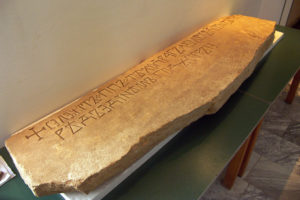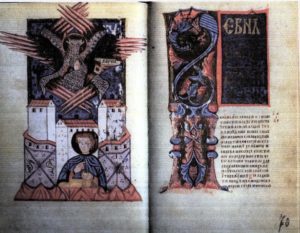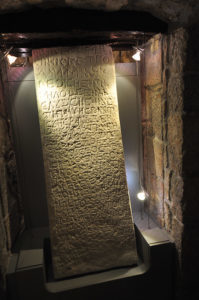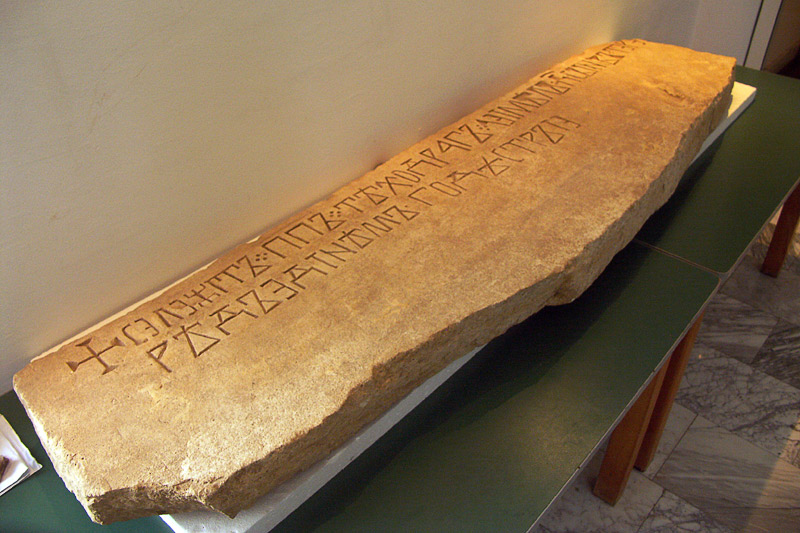
First books written on Cyrillic and used on territory of the medieval Bosnia (without Zachlumia and Adriatic coast), were accepted in Bosnia near the end of XI century, in already formed Serbian redaction. Bosnian diocese was established in this period. It was subjected to jurisdiction of Bar archiepiscopacy in church administration while politically, it was part of the Serbian state with center in Dioclea.[1] This is confirmed by their language, paleographic and orthographic compatibility with monuments created in Serbian state of that time, before St.Sava redaction was formed.[2] Biblical and other church books in Zachlumia were, for several centuries, created directly in lee of biblical literature of Serbian Orthodox church while Zachlumia itself was under direct rule of Nemanjići dynasty. One of the most valuable Serbian church books, Miroslav Gospel, was written in Zachlumia for knyaz Miroslav, brother of Stefan Nemanja. Today, through use of quasi-historical means and methods, Croatian, Bosnian and Montenegrin scholars are trying to usurp both the Miroslav Gospel and Miroslav himself as parts of Serbian cultural heritage. These scholars go so far as to claim he wasn’t even brother of Stefan Nemanja.[3] Miroslav himself, in inscription found on the church in Bijelo Polje, proclaims that he is son of Zavid, by name servant of God Stjepan Miroslav, zachlumian knyaz…[4], while during construction of St. Kozma and Damjan (Cosmas and Damian) church in Podgradj near Blagaj, Miroslav writes it happened in the days of great zupan glorious Nemanja. [5] We believe this testimony from Miroslav himself, where he names himself son of Zavid, father to Stefan Nemanja as well, is enough to deny all malicious and quasi-scientific constructions.
Biblical literature in Bosnia, besides Serbian language, is connected with Serbian biblical redaction through Cyrillic letter as well, and in its entirety, identical translation repertoire, same codicological and liturgical form of the biblical works.[6] Medieval Bosnian biblical literature was based, in essence, on transcription, and in this manner many gospels and other manuscripts of liturgical character, such as: Divoš Gospel, Čajniče Gospel, Code of Radosav the Christian, Hval Code and many others, came into being.[7]

In case of Čajniče Gospel creation we have one example of cooperation between members of “Bosnian church” and members of Serbian Orthodox church. First part of this work was written by certain, so far, unknown Bosnian Christian while the rest was completed, most likely, by monks from monastery of Dobrun. [8] One of the secondary scribes working on the gospel deemed it important enough to point out in one section that this is book of the Jesus Christ son of the great God, while in another section he pointed out that this is the book of Jesus Christ the living God, in this manner, probably, trying to confront the Franciscans in Bosnia who have earlier accused Bosnian church of denouncing divine nature of son of God.[9]
In their functional purpose, biblical books from Bosnia are divided on those used inside the old Bosnian diocese, those used by “Bosnian church” and those used by Serbian Orthodox church. Structural and thematic compatibility of these books with biblical books from eastern branch of south Slavic literature points that their common center was in Ohrid literary school, with their direct origin being in biblical works of older Serbian, Zeta-Zachlumia redaction, and partially in Rascian redaction from first generation of Cyrillic transcriptions.[10] This is substantiated trough, for example, Gospel of ban Matija Ninoslav, which, in terms of language used and text, matches Gospel of Vukan, written for larger part in rascian style. Gospel of Ninoslav holds the same liturgical division according to the form of the Orthodox church, the same as Čajniče Gospel and Code of Christian Hval.[11] Influences in worldly, and in one sort of ideologically neutral church literature spread from the neighboring Serbian areas. Scribe from Polimlje, in accordance with political ideology of the Kotromanić court composes first Bosnian genealogies aiming to connect dynasty of Kotromanić with dynasty of Nemanjići in that manner.[12]

While majority of Bosnian bibliographical literature formed language, writing system, structural and ideological whole with the rest of the Serbian areas, influences from Croatian Glagolitic area was impossible due to use of both Glagolitic letter and Chakavian dialect, which were foreign to the medieval Bosnian state. Glagolitic literacy was limited to western parts of the Bosnian state.[13] These areas were incorporated in Bosnia during XIV but stayed linked with their Glagolitic literary center. Missal of Hrvoje, for example, was transcribed in Catholic Split by rules of roman court and only through its dedication does it belong into Bosnian literature.[14]
In Croatian Glagolitic area, structure of the biblical books differed from that in Bosnian-Zachlumia area, with complete lack of Four Gospels, praksapostola, psalters and complete texts of the Apocalypse. These facts confirm that Croatian Glagolitic letter was not direct or indirect source for the Bosnian biblical literature.[15]
Epigraphic monuments on the territory of medieval Bosnian state are divided in two separate groups, according to their area of creation. One of them is in what was initial Bosnia, while the other is Zachlumia. Its worth to mention here that one must differentiate between monuments themselves from these two areas and time of their creation. Oldest epigraphic writing from Zachlumia is the Zachlumia (Humska) tablet, originating from X or start of the XI century.[16] Although it was created on ethnically Serbian territory, three centuries before those lands will come under rule of Bosnian Kotromanići dynasty and half a century after breakdown of the unified Serbian state under knyaz Časlav (933-943) [17] which included Bosnia as its constituent part, it is today, unscientifically, often referred to as “oldbosnian stone writing”.[18] On other hand, through quasi-scientific works as well, Zachlumia tablet is placed amongst oldest monuments of the “western or Croatian Cyrillic”.[19] Besides Zachlumia tablet, there is also Blagaj writing found in 1912 in Blagaj near Mostar, which remains still undated.[20]
First tombstones with inscriptions were also from Zachlumia. Within medieval necropolis in Police near Trebinje, gravestone of Trebinje zupan Grda was found[21] (died between 1151 – 1178) and zupan Pribiša from 1241.[22] These inscriptions were created during Nemanjići rule over Zachlumia, but the burial tradition from this period continued into the time when these lands came under Kotromanići control.[23] Common characteristics of all Zachlumia and Bosnia tablets were Cyrillic letter and Serbian language which were used during inscription creation. There is no difference between monument stones with inscriptions from period of Nemanjići and from time when Bosnia ruled over Zachlumia.[24] From territories of original Bosnia, one of the first inscriptions was that of ban Kulin, placed on a church ban himself raised. This inscription, written in Cyrillic letter and with use of popular speech, reveals that ban constructed the church in 1193, in contemporary village of Muhašinovići, near Visoko.[25] Church dedicated to St.Georgije (George), near Zenica, was built during reign of ban Kulin by judge Grdeša. Cyrillic inscription tells us that the church was consecrated by episcope while the inscription itself was composed by priest Pro(kopije) (Procopius).[26]
These two inscriptions, from area of primary Bosnia, in terms of language, paleography and orthography coincide with monuments created in Serbian state of that time, with whom, until first decades of XII century, for longer or shorter periods, Bosnia made one political and church-administrative whole.[27] Inscriptions differ in dialects depending on area of medieval Bosnian state in which they were made. Shapes of Cyrillic characters were taken from Serbian miniscule letter but, probably due to lower level of literacy in some parts of medieval Bosnian state, experienced certain lesser deformations.[28] Everything mentioned above attests to language, paleographic and literary unity of medieval Bosnian state with other Serbian medieval areas.
Author: Boris Radaković
Translation: Ljubiša Malenica
[1] Д. Драгојловић, Историја српске књижевности у средњовековној босанској држави, Нови Сад 1997, 36.
[2] Исто, 36.
[3] B. Zelić-Bučan, Članci i rasprave iz starije hrvatske prošlosti, Zagreb 1994.
[4] Г. Томовић, Морфологија ћириличних натписа на Балкану, Београд 1974, 37.
[5] М. Диздар, Стари босански текстови, Сарајево 1971, 47.
[6] H. Kuna, Bosanski rukopisni kodeksi u svijetlu južnoslovenskih redakcija staroslovenskog, Radovi sa simpozijuma „Srednjovjekovna Bosna i evropska kultura“, Zenica 1973, 91.
[7] Б. Самарџић, Термин босанчица као заблуда у историјском развоју српског језика, Слово – часопис за српски језик, књижевност и културу, број 23, Никшић 2009, 85.
[8] Д. Драгојловић, Историја српске књижевности, 101.
[9] Исто, 102.
[10] Исто, 82.
[11] Исто, 41.
[12] Исто, 45.
[13] В. Ћоровић, Босна и Херцеговина, Београд 1927,87.
[14] Д. Драгојловић, Историја српске књижевности, 52.
[15] Исто, 82.
[16] http://www.rastko.org.rs/knjizevnost/jderetic_knjiz/jderetic-knjiz_01_c.html
[17] Т. Живковић, Портрети српских владара, Београд 2006, 71.
[18] J. Hođžić, Starobosanski natpisi ukrug – Jezik bosanskih spomenika pismenosti na primjeru dva epitafa iz Vlahovića kod Ljubinja, Godišnjak „Slovo Gorčina“, br.32, Stolac 2010, 68-74.
[19] http://www.croatianhistory.net/etf/boljuni_m_simic.pdf
[20] П. Ђорђић, Историја српске ћирилице, 67.
[21] (Zupan Grda was mentioned by byzantine writer John Kinnamos as one of the prominent generals in the army of the Rascian great zupan Uroš II during war between Serbs and Byzantium from 1150 when he was captured by the Byzantines. When zupan Desa decided to bestow island of Mljet to the monastery of St.Maria of Pulsano, found on the hilltop Gorgano in Apulia, charter commemorating this act lists Grda as one of the witnesses.) Византијски извори за историју народа Југославије, 33.
[22] M. Vego, Iz historije srednjovjekovne Bosne i Hercegovine, 316-317.
[23] Исто, 318.
[24] Исто, 317-318.
[25] Д. Драгојловић, Историја српске књижевности, Београд 1990, 159
[26] Исто.
[27] Исто, 14.
[28] Исто, 164.
Донирајте или се рекламирајте на „Срби у Босни и Херцеговини кроз епохе и судбине“ једином сајту на свијету који описује живот нашег народа на просторима БиХ од насељавања Срба у 7. вијеку до одбрамбено-отаџбинског рата а кроз призме политичке, културне и духовне историје.


Very great post. thank you!
Pretty nice post. Thank you so much!
This is a really good read for me, thank you!